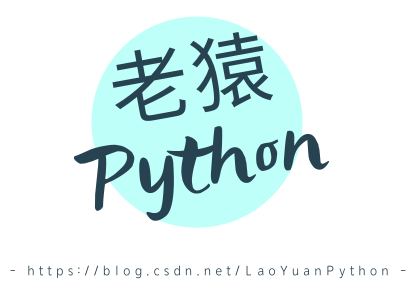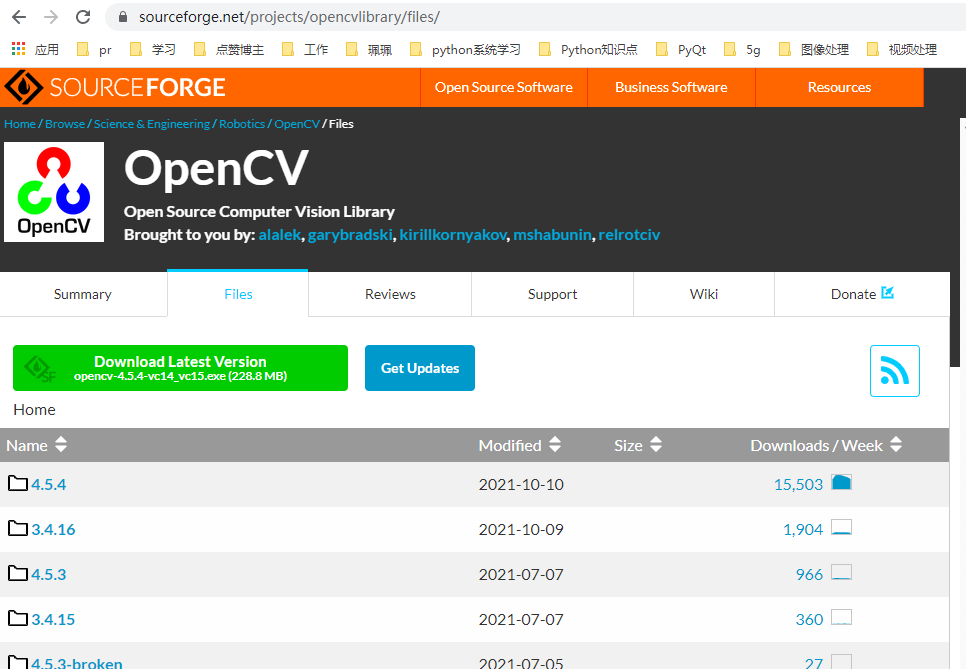
1, Introduction
Recently, I received a request from several netizens to provide the source code of CLAHE in OpenCV. Here, I directly share the source code of CLAHE.CPP in OpenCV4.54.
2, OpenCV source code download
Download address: https://sourceforge.net/projects/opencvlibrary/files/
There are versions 3.4.10 – 4.5.4, but the download is very slow, and the old ape takes a lot of effort. You can consider a special download tool to download. If you really can't get down, please pay attention to the wechat public account of old ape Python and send a message to old ape.
3, CLAHE C + + source code
/*M///
//
// IMPORTANT: READ BEFORE DOWNLOADING, COPYING, INSTALLING OR USING.
//
// By downloading, copying, installing or using the software you agree to this license.
// If you do not agree to this license, do not download, install,
// copy or use the software.
//
//
// License Agreement
// For Open Source Computer Vision Library
//
// Copyright (C) 2013, NVIDIA Corporation, all rights reserved.
// Copyright (C) 2014, Itseez Inc., all rights reserved.
// Third party copyrights are property of their respective owners.
//
// Redistribution and use in source and binary forms, with or without modification,
// are permitted provided that the following conditions are met:
//
// * Redistribution's of source code must retain the above copyright notice,
// this list of conditions and the following disclaimer.
//
// * Redistribution's in binary form must reproduce the above copyright notice,
// this list of conditions and the following disclaimer in the documentation
// and/or other materials provided with the distribution.
//
// * The name of the copyright holders may not be used to endorse or promote products
// derived from this software without specific prior written permission.
//
// This software is provided by the copyright holders and contributors "as is" and
// any express or implied warranties, including, but not limited to, the implied
// warranties of merchantability and fitness for a particular purpose are disclaimed.
// In no event shall the copyright holders or contributors be liable for any direct,
// indirect, incidental, special, exemplary, or consequential damages
// (including, but not limited to, procurement of substitute goods or services;
// loss of use, data, or profits; or business interruption) however caused
// and on any theory of liability, whether in contract, strict liability,
// or tort (including negligence or otherwise) arising in any way out of
// the use of this software, even if advised of the possibility of such damage.
//
//M*/
#include "precomp.hpp"
#include "opencl_kernels_imgproc.hpp"
// ----------------------------------------------------------------------
// CLAHE
#ifdef HAVE_OPENCL
namespace clahe
{
static bool calcLut(cv::InputArray _src, cv::OutputArray _dst,
const int tilesX, const int tilesY, const cv::Size tileSize,
const int clipLimit, const float lutScale)
{
cv::ocl::Kernel k("calcLut", cv::ocl::imgproc::clahe_oclsrc);
if(k.empty())
return false;
cv::UMat src = _src.getUMat();
_dst.create(tilesX * tilesY, 256, CV_8UC1);
cv::UMat dst = _dst.getUMat();
int tile_size[2];
tile_size[0] = tileSize.width;
tile_size[1] = tileSize.height;
size_t localThreads[3] = { 32, 8, 1 };
size_t globalThreads[3] = { tilesX * localThreads[0], tilesY * localThreads[1], 1 };
int idx = 0;
idx = k.set(idx, cv::ocl::KernelArg::ReadOnlyNoSize(src));
idx = k.set(idx, cv::ocl::KernelArg::WriteOnlyNoSize(dst));
idx = k.set(idx, tile_size);
idx = k.set(idx, tilesX);
idx = k.set(idx, clipLimit);
k.set(idx, lutScale);
return k.run(2, globalThreads, localThreads, false);
}
static bool transform(cv::InputArray _src, cv::OutputArray _dst, cv::InputArray _lut,
const int tilesX, const int tilesY, const cv::Size & tileSize)
{
cv::ocl::Kernel k("transform", cv::ocl::imgproc::clahe_oclsrc);
if(k.empty())
return false;
int tile_size[2];
tile_size[0] = tileSize.width;
tile_size[1] = tileSize.height;
cv::UMat src = _src.getUMat();
_dst.create(src.size(), src.type());
cv::UMat dst = _dst.getUMat();
cv::UMat lut = _lut.getUMat();
size_t localThreads[3] = { 32, 8, 1 };
size_t globalThreads[3] = { (size_t)src.cols, (size_t)src.rows, 1 };
int idx = 0;
idx = k.set(idx, cv::ocl::KernelArg::ReadOnlyNoSize(src));
idx = k.set(idx, cv::ocl::KernelArg::WriteOnlyNoSize(dst));
idx = k.set(idx, cv::ocl::KernelArg::ReadOnlyNoSize(lut));
idx = k.set(idx, src.cols);
idx = k.set(idx, src.rows);
idx = k.set(idx, tile_size);
idx = k.set(idx, tilesX);
k.set(idx, tilesY);
return k.run(2, globalThreads, localThreads, false);
}
}
#endif
namespace
{
template <class T, int histSize, int shift>
class CLAHE_CalcLut_Body : public cv::ParallelLoopBody
{
public:
CLAHE_CalcLut_Body(const cv::Mat& src, const cv::Mat& lut, const cv::Size& tileSize, const int& tilesX, const int& clipLimit, const float& lutScale) :
src_(src), lut_(lut), tileSize_(tileSize), tilesX_(tilesX), clipLimit_(clipLimit), lutScale_(lutScale)
{
}
void operator ()(const cv::Range& range) const CV_OVERRIDE;
private:
cv::Mat src_;
mutable cv::Mat lut_;
cv::Size tileSize_;
int tilesX_;
int clipLimit_;
float lutScale_;
};
template <class T, int histSize, int shift>
void CLAHE_CalcLut_Body<T,histSize,shift>::operator ()(const cv::Range& range) const
{
T* tileLut = lut_.ptr<T>(range.start);
const size_t lut_step = lut_.step / sizeof(T);
for (int k = range.start; k < range.end; ++k, tileLut += lut_step)
{
const int ty = k / tilesX_;
const int tx = k % tilesX_;
// retrieve tile submatrix
cv::Rect tileROI;
tileROI.x = tx * tileSize_.width;
tileROI.y = ty * tileSize_.height;
tileROI.width = tileSize_.width;
tileROI.height = tileSize_.height;
const cv::Mat tile = src_(tileROI);
// calc histogram
cv::AutoBuffer<int> _tileHist(histSize);
int* tileHist = _tileHist.data();
std::fill(tileHist, tileHist + histSize, 0);
int height = tileROI.height;
const size_t sstep = src_.step / sizeof(T);
for (const T* ptr = tile.ptr<T>(0); height--; ptr += sstep)
{
int x = 0;
for (; x <= tileROI.width - 4; x += 4)
{
int t0 = ptr[x], t1 = ptr[x+1];
tileHist[t0 >> shift]++; tileHist[t1 >> shift]++;
t0 = ptr[x+2]; t1 = ptr[x+3];
tileHist[t0 >> shift]++; tileHist[t1 >> shift]++;
}
for (; x < tileROI.width; ++x)
tileHist[ptr[x] >> shift]++;
}
// clip histogram
if (clipLimit_ > 0)
{
// how many pixels were clipped
int clipped = 0;
for (int i = 0; i < histSize; ++i)
{
if (tileHist[i] > clipLimit_)
{
clipped += tileHist[i] - clipLimit_;
tileHist[i] = clipLimit_;
}
}
// redistribute clipped pixels
int redistBatch = clipped / histSize;
int residual = clipped - redistBatch * histSize;
for (int i = 0; i < histSize; ++i)
tileHist[i] += redistBatch;
if (residual != 0)
{
int residualStep = MAX(histSize / residual, 1);
for (int i = 0; i < histSize && residual > 0; i += residualStep, residual--)
tileHist[i]++;
}
}
// calc Lut
int sum = 0;
for (int i = 0; i < histSize; ++i)
{
sum += tileHist[i];
tileLut[i] = cv::saturate_cast<T>(sum * lutScale_);
}
}
}
template <class T, int shift>
class CLAHE_Interpolation_Body : public cv::ParallelLoopBody
{
public:
CLAHE_Interpolation_Body(const cv::Mat& src, const cv::Mat& dst, const cv::Mat& lut, const cv::Size& tileSize, const int& tilesX, const int& tilesY) :
src_(src), dst_(dst), lut_(lut), tileSize_(tileSize), tilesX_(tilesX), tilesY_(tilesY)
{
buf.allocate(src.cols << 2);
ind1_p = buf.data();
ind2_p = ind1_p + src.cols;
xa_p = (float *)(ind2_p + src.cols);
xa1_p = xa_p + src.cols;
int lut_step = static_cast<int>(lut_.step / sizeof(T));
float inv_tw = 1.0f / tileSize_.width;
for (int x = 0; x < src.cols; ++x)
{
float txf = x * inv_tw - 0.5f;
int tx1 = cvFloor(txf);
int tx2 = tx1 + 1;
xa_p[x] = txf - tx1;
xa1_p[x] = 1.0f - xa_p[x];
tx1 = std::max(tx1, 0);
tx2 = std::min(tx2, tilesX_ - 1);
ind1_p[x] = tx1 * lut_step;
ind2_p[x] = tx2 * lut_step;
}
}
void operator ()(const cv::Range& range) const CV_OVERRIDE;
private:
cv::Mat src_;
mutable cv::Mat dst_;
cv::Mat lut_;
cv::Size tileSize_;
int tilesX_;
int tilesY_;
cv::AutoBuffer<int> buf;
int * ind1_p, * ind2_p;
float * xa_p, * xa1_p;
};
template <class T, int shift>
void CLAHE_Interpolation_Body<T, shift>::operator ()(const cv::Range& range) const
{
float inv_th = 1.0f / tileSize_.height;
for (int y = range.start; y < range.end; ++y)
{
const T* srcRow = src_.ptr<T>(y);
T* dstRow = dst_.ptr<T>(y);
float tyf = y * inv_th - 0.5f;
int ty1 = cvFloor(tyf);
int ty2 = ty1 + 1;
float ya = tyf - ty1, ya1 = 1.0f - ya;
ty1 = std::max(ty1, 0);
ty2 = std::min(ty2, tilesY_ - 1);
const T* lutPlane1 = lut_.ptr<T>(ty1 * tilesX_);
const T* lutPlane2 = lut_.ptr<T>(ty2 * tilesX_);
for (int x = 0; x < src_.cols; ++x)
{
int srcVal = srcRow[x] >> shift;
int ind1 = ind1_p[x] + srcVal;
int ind2 = ind2_p[x] + srcVal;
float res = (lutPlane1[ind1] * xa1_p[x] + lutPlane1[ind2] * xa_p[x]) * ya1 +
(lutPlane2[ind1] * xa1_p[x] + lutPlane2[ind2] * xa_p[x]) * ya;
dstRow[x] = cv::saturate_cast<T>(res) << shift;
}
}
}
class CLAHE_Impl CV_FINAL : public cv::CLAHE
{
public:
CLAHE_Impl(double clipLimit = 40.0, int tilesX = 8, int tilesY = 8);
void apply(cv::InputArray src, cv::OutputArray dst) CV_OVERRIDE;
void setClipLimit(double clipLimit) CV_OVERRIDE;
double getClipLimit() const CV_OVERRIDE;
void setTilesGridSize(cv::Size tileGridSize) CV_OVERRIDE;
cv::Size getTilesGridSize() const CV_OVERRIDE;
void collectGarbage() CV_OVERRIDE;
private:
double clipLimit_;
int tilesX_;
int tilesY_;
cv::Mat srcExt_;
cv::Mat lut_;
#ifdef HAVE_OPENCL
cv::UMat usrcExt_;
cv::UMat ulut_;
#endif
};
CLAHE_Impl::CLAHE_Impl(double clipLimit, int tilesX, int tilesY) :
clipLimit_(clipLimit), tilesX_(tilesX), tilesY_(tilesY)
{
}
void CLAHE_Impl::apply(cv::InputArray _src, cv::OutputArray _dst)
{
CV_INSTRUMENT_REGION();
CV_Assert( _src.type() == CV_8UC1 || _src.type() == CV_16UC1 );
#ifdef HAVE_OPENCL
bool useOpenCL = cv::ocl::isOpenCLActivated() && _src.isUMat() && _src.dims()<=2 && _src.type() == CV_8UC1;
#endif
int histSize = _src.type() == CV_8UC1 ? 256 : 65536;
cv::Size tileSize;
cv::_InputArray _srcForLut;
if (_src.size().width % tilesX_ == 0 && _src.size().height % tilesY_ == 0)
{
tileSize = cv::Size(_src.size().width / tilesX_, _src.size().height / tilesY_);
_srcForLut = _src;
}
else
{
#ifdef HAVE_OPENCL
if(useOpenCL)
{
cv::copyMakeBorder(_src, usrcExt_, 0, tilesY_ - (_src.size().height % tilesY_), 0, tilesX_ - (_src.size().width % tilesX_), cv::BORDER_REFLECT_101);
tileSize = cv::Size(usrcExt_.size().width / tilesX_, usrcExt_.size().height / tilesY_);
_srcForLut = usrcExt_;
}
else
#endif
{
cv::copyMakeBorder(_src, srcExt_, 0, tilesY_ - (_src.size().height % tilesY_), 0, tilesX_ - (_src.size().width % tilesX_), cv::BORDER_REFLECT_101);
tileSize = cv::Size(srcExt_.size().width / tilesX_, srcExt_.size().height / tilesY_);
_srcForLut = srcExt_;
}
}
const int tileSizeTotal = tileSize.area();
const float lutScale = static_cast<float>(histSize - 1) / tileSizeTotal;
int clipLimit = 0;
if (clipLimit_ > 0.0)
{
clipLimit = static_cast<int>(clipLimit_ * tileSizeTotal / histSize);
clipLimit = std::max(clipLimit, 1);
}
#ifdef HAVE_OPENCL
if (useOpenCL && clahe::calcLut(_srcForLut, ulut_, tilesX_, tilesY_, tileSize, clipLimit, lutScale) )
if( clahe::transform(_src, _dst, ulut_, tilesX_, tilesY_, tileSize) )
{
CV_IMPL_ADD(CV_IMPL_OCL);
return;
}
#endif
cv::Mat src = _src.getMat();
_dst.create( src.size(), src.type() );
cv::Mat dst = _dst.getMat();
cv::Mat srcForLut = _srcForLut.getMat();
lut_.create(tilesX_ * tilesY_, histSize, _src.type());
cv::Ptr<cv::ParallelLoopBody> calcLutBody;
if (_src.type() == CV_8UC1)
calcLutBody = cv::makePtr<CLAHE_CalcLut_Body<uchar, 256, 0> >(srcForLut, lut_, tileSize, tilesX_, clipLimit, lutScale);
else if (_src.type() == CV_16UC1)
calcLutBody = cv::makePtr<CLAHE_CalcLut_Body<ushort, 65536, 0> >(srcForLut, lut_, tileSize, tilesX_, clipLimit, lutScale);
else
CV_Error( CV_StsBadArg, "Unsupported type" );
cv::parallel_for_(cv::Range(0, tilesX_ * tilesY_), *calcLutBody);
cv::Ptr<cv::ParallelLoopBody> interpolationBody;
if (_src.type() == CV_8UC1)
interpolationBody = cv::makePtr<CLAHE_Interpolation_Body<uchar, 0> >(src, dst, lut_, tileSize, tilesX_, tilesY_);
else if (_src.type() == CV_16UC1)
interpolationBody = cv::makePtr<CLAHE_Interpolation_Body<ushort, 0> >(src, dst, lut_, tileSize, tilesX_, tilesY_);
cv::parallel_for_(cv::Range(0, src.rows), *interpolationBody);
}
void CLAHE_Impl::setClipLimit(double clipLimit)
{
clipLimit_ = clipLimit;
}
double CLAHE_Impl::getClipLimit() const
{
return clipLimit_;
}
void CLAHE_Impl::setTilesGridSize(cv::Size tileGridSize)
{
tilesX_ = tileGridSize.width;
tilesY_ = tileGridSize.height;
}
cv::Size CLAHE_Impl::getTilesGridSize() const
{
return cv::Size(tilesX_, tilesY_);
}
void CLAHE_Impl::collectGarbage()
{
srcExt_.release();
lut_.release();
#ifdef HAVE_OPENCL
usrcExt_.release();
ulut_.release();
#endif
}
}
cv::Ptr<cv::CLAHE> cv::createCLAHE(double clipLimit, cv::Size tileGridSize)
{
return makePtr<CLAHE_Impl>(clipLimit, tileGridSize.width, tileGridSize.height);
}
If you have any questions about the content of the article, you can leave a message in the blog comment area, or pay attention to: Send a message to the old ape Python wechat public account for consultation.

For more information on image histogram processing, please refer to< *** >Introduction to.
For more information on image processing, please refer to the column< https://blog.csdn.net/laoyuanpython/category_9979286.html Opencv Python graphics and image processing >,<https://blog.csdn.net/laoyuanpython/category_10581071.html Opencv Python beginner difficult problem set >And< Fundamentals of image processing >Introduction to.
Blogging is not easy. Please support:
If you get something from reading this article, please like, comment and collect. Thank you for your support!
Paid column on old apes
- Paid column< https://blog.csdn.net/laoyuanpython/category_9607725.html Developing graphical interface Python applications using PyQt This paper introduces the basic tutorial of PyQt graphical interface development based on Python, and the corresponding article directory is< https://blog.csdn.net/LaoYuanPython/article/details/107580932 Python application column directory for developing graphical interface using PyQt>;
- Paid column< https://blog.csdn.net/laoyuanpython/category_10232926.html Moviepy audio and video development column )This paper introduces in detail the class related methods of moviepy audio and video clip synthesis processing and the processing of related clip synthesis scenes using related methods. The corresponding article directory is< https://blog.csdn.net/LaoYuanPython/article/details/107574583 Moviepy audio and video development column directory>;
- Paid column< https://blog.csdn.net/laoyuanpython/category_10581071.html Opencv Python beginner difficult problem set >For< https://blog.csdn.net/laoyuanpython/category_9979286.html Opencv Python graphics and image processing >The accompanying column is the integration of the author's personal perception of some problems encountered in the study of OpenCV Python graphics and image processing. The relevant materials are basically the results of repeated research by old apes, which is helpful for opencv Python beginners to deeply understand OpenCV. The corresponding article directory is< https://blog.csdn.net/LaoYuanPython/article/details/109713407 Opencv Python beginner difficult problem set column directory >
- Paid column< https://blog.csdn.net/laoyuanpython/category_10762553.html Getting started with Python crawler From the perspective of an Internet front-end development Xiaobai, this paper introduces the contents of crawler development, including the basic knowledge of crawler introduction, as well as the practical contents such as crawling CSDN article information, blogger information, giving praise to articles, comments and so on.
The first two columns are suitable for white readers with a certain Python foundation but no relevant knowledge. Please combine the third column< https://blog.csdn.net/laoyuanpython/category_9979286.html Opencv Python graphics and image processing >Learning and using.
For colleagues who lack Python foundation, you can use the free column of old ape< https://blog.csdn.net/laoyuanpython/category_9831699.html Column: Python basic tutorial directory )Learn Python from scratch.
If you are interested and willing to support the readers of old apes, you are welcome to buy the paid column.